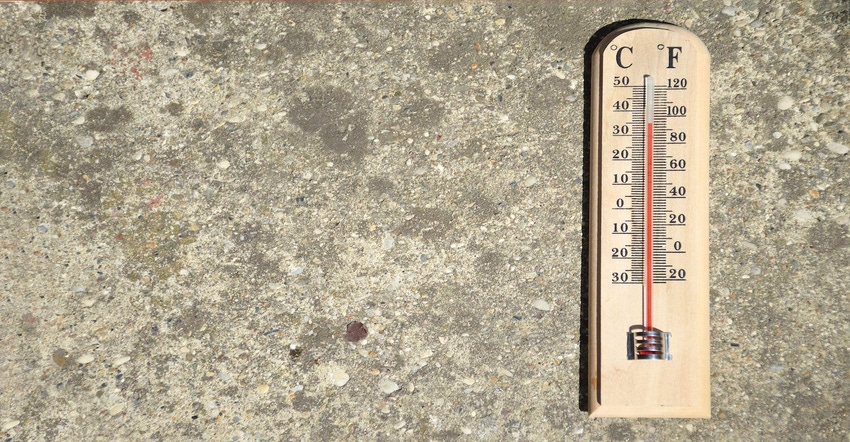How to Prepare for Hot Weather Structural Concrete Placement
Placing concrete in hot weather on structural projects requires special considerations to ensure a quality placement. Concrete producers, placing contractors, and testing agencies must understand their responsibilities per code requirements.

I have been involved with many concrete placements around the world. Some of the most challenging of these projects were in Saudi Arabia. The weather was brutal: daytime temperatures exceeded 110 degrees, humidity was near zero and winds came off the desert.
Fortunately, these projects were successful. The concrete producer, the contractor, and the testing agency worked together to achieve a successful concrete placement.
These were structural concrete projects, so our preconstruction meetings focused on ACI 305R (Guide to Hot Weather Concreting). The Guide provides the basic information from experts that can be used for advice when planning and executing hot weather concrete placement. Unfortunately, the Guide is not written in mandatory language and thus does not provide the requirements that each party involved in a hot weather placement must do.
So, in this paper, I will discuss what the code (ACI 318-19 “Building Requirements for Structural Concrete”) and specification (ACI 301-20 “Specifications for Concrete Construction”) required for hot weather concreting. These documents are written in mandatory language and typically are referenced in structural concrete specifications. They describe what the batch plant, contractor(s) and the testing laboratory/ inspection agency are required to do. I will discuss each one separately.
What Is Hot Weather Concreting
Before we define every party’s responsibility, it’s important to define what hot weather concreting is. The American Concrete Institute (ACI) defines hot weather concreting as “one or a combination of the following conditions that tends to impair the quality of freshly mixed or hardened concrete by accelerating the rate of moisture loss and rate of cement hydration or otherwise causing detrimental results: high ambient temperatures; high concrete temperatures; low relative humidity; and high wind speed.”
It is very important to realize that hot weather concreting involves more than just high concrete or air temperatures. Every party must be proactive in adopting procedures that reduces the chances of impairment.
Batch Plant Responsibilities
ACI 301.4.2.5(b) Maximum temperature—Unless otherwise specified, temperature of concrete as delivered shall not exceed 95°F.
ACI 318.26.5.5.2(a) Concrete materials and production methods shall be selected so that the concrete temperature at delivery complies with the specified temperature limits.
These two requirements clearly put the responsibility on the batch plant to deliver concrete to the jobsite that is below a specified temperature.
An engineer at a batch plant in the Middle East contacted me about how to reduce the cost required to keep their batched concrete below their temperature requirements. Their temperatures routinely exceeded 110°F. The management of the batch plant was concerned about the expense of keeping the concrete below their specified maximum concrete temperatures.
We discussed some of the methods listed in ACI 305R such as shading and cooling the stockpiles, using white drums on the trucks, spraying water on the drums of the trucks during delivery and using chilled water, ice, admixtures, and slower setting cements. I told him that in the southern USA, some batch plants are using liquid nitrogen to lower the temperature of the concrete. Liquid nitrogen is at -320°F and that can easily bring the temperature of the concrete below their temperature requirements.
The engineer told me the batch plant management was not prepared to install the nitrogen cooling equipment and they were already incorporating most of the recommendations from ACI 305R that I mentioned. The engineer reported back to management that they were using the same methods of controlling concrete temperatures that is commonly used and that the cost of keeping the concrete below the specified temperature was just a part of doing business in their environment.
Contractor Responsibilities
ACI 318.26.5.5.2(b) Handling, placing, protection and curing procedures shall limit concrete temperatures or water evaporation that can reduce the strength, serviceability and durability of the member or structure.
This is a general statement that put the burden on the contractor for temperature control and for water evaporation during placement and curing. In the code’s commentary, the text encourages the contractor to go to ACI 305R to find the detail of how to accomplish this.
Much of the concern here is to prevent plastic shrinkage cracks from forming. Plastic shrinkage cracks form when the evaporation rate from the concrete surface is so high that water is ripped from the fresh concrete resulting in cracks on the concrete surface. Research and practical experience have shown that four factors determine the evaporation rate from a fresh concrete surface: air temperature, concrete temperature, humidity, and wind velocity. The air temperature, humidity and wind must be measured right above the placement thus a handheld weather stations at ideal to capture this information. The concrete temperature is a routine test that the testing laboratory can provide.
The evaporation rate can be calculated with this collected data however it is a very complex formula.
ACI 305R has simplified the calculations by providing a chart that can be easily used to predict the evaporation rate. I along with many others have developed a computer program that can be used as a pre-pour planner to determine if plastic shrinkage cracks are likely to form. (If you want a copy of this computer program, contact me at [email protected])
Since the contractor determines the time of the concrete placements, they must also consider the weather conditions and if they need to take extra precautions during the placement. This could include placing concrete at night (wind speed and temperatures tend to be lower, humidity higher) and take precautions such as erecting wind screens, fogging during placement and using evaporation retarders. Sometimes it would be advisable to delay a concrete placement until weather conditions are more favorable.
ACI 301.5.3.1(c) If temperature of reinforcement, embedments, or forms is greater than 120°F, use a fine mist of water to moisten and cool hot surfaces. Remove standing water before placing concrete.
This requirement implies that the contractor must measure the surface temperatures of the reinforcement, embedments and forms prior to placement in hot weather. I would recommend that the infrared thermometer be used. This equipment is easy to use, inexpensive and provides a quick answer if cooling procedures are necessary. This statement also requires that any standing water used for cooling purposes must be removed prior to concrete placement.
ACI 301.5.3.6.5(b)) Ponding—Build a dike around concrete and flood surface with water. Entire surface is to remain covered continuously with water for duration of curing period. Temperature of water used shall be at least 50°F and not be more than 35°F colder than surface temperature of the concrete at the time the water and concrete come in contact.
Water that is less than 50°F will slow hydration and strength development thus not desirable for most construction. Water that is more than 35°F colder than surface temperature can cause thermal cracking. Monitoring these temperatures of the water can easily be accomplished by using the infrared thermometer.
ACI 318.26.5.3.2(a) Concrete, other than high-early -strengths shall be maintained at a temperature of at least 50°F and in a moist condition for at least 7 days after placement except if accelerated curing is used.
ACI 318.26.5.3.2(e) Procedures for protecting and curing concrete shall be considered adequate if (1) or (2) are satisfied:
Average strength of field-cured cylinders at test age designated for determination of f’c is equal to or at least 85 percent of that of companion standard -cured cylinders
Average strength of field-cured cylinders test age exceeds f’c by more 500 psi
ACI 301.5.3.6.6(a) Unless otherwise specified, continue curing measures for at least 7 days after placement. Unless otherwise specified, cure high-early-strength concrete for at least 3 days after placement
ACI 301.5.3.6.6(b) Unless otherwise specified, curing measures may be terminated before the specified minimum duration in 5.3.6.6(a) if one of the following conditions is satisfied:
(a) Tests of at least two 6 x 12 in. or at least three 4 x 8 in. cylinders that have been field cured in accordance with ASTM C31/C31M indicate compressive strength of at least 70 percent of fc′ when tested in accordance with ASTM C39/C39M.
(b) The compressive strength of laboratory-cured cylinders, representative of the in-place concrete, exceeds 85 percent fc′, provided the temperature of the in-place concrete has been maintained at 50°F or higher during curing.
(c) Concrete strength reaches fc′ as determined by accepted in-place test methods meeting the requirements of 2.3.4.2. 5.3.6.6(c)
These specifications are to provide the guidelines for the length of time for curing plus when the contractor can be terminated their curing procedure.
In hot weather, maintaining the concrete temperature above 50 °F is not a problem, however keeping concrete moist for seven days may be a challenge when using water curing procedures. For these reasons, many contractors will use curing compounds if they are allowed by their job specifications. These requirements also point out that the termination of curing before seven days is not an arbitrary decision. It must be based on test results that the concrete has achieved some verifiable concrete strength.
Testing Laboratory/ Inspection Agency Responsibilities:
ACI 301.1.7.3.3(d) For each concrete mixture cast in 1 day, obtain samples of fresh concrete in accordance with ASTM C172/ C172M. Truckloads or batches of concrete will be sampled on a random basis. Unless otherwise specified, at least one composite sample will be obtained for consecutive 150 yd3 of concrete or 5000 ft2 of surface area of slabs or walls, or fractions thereof. At least five strength tests for a given concrete mixture will be required for Work. If total quantity of a given concrete mixture is less than 50 yd3 , strength tests may be waived. Sampled concrete used to mold strength test specimens (ASTM C31/C31M) will be tested for slump (ASTM C143/ C143M) or slump flow (ASTM C1611/C1611M), air content (ASTM C231/C231M or ASTM C173/C173M), temperature (ASTM C1064/C1064M), and density (ASTM C138/ C138M).
This specification incorporates ASTM C31 (Standard Practice for Making and Curing Concrete Test Specimens in the Field). This requires that concrete cylinders with design strength below 6000 psi are to be maintained between 60-80°F; concreted cylinders with design strengths above 6000 psi are to be maintained between 68 - 78°F while in the field. The cylinders are also to be protected from direct exposure to sunlight. The maximum and minimum temperatures of the concrete cylinders while in the field are to be recorded. This is best accomplished by a max/min thermometer placed with the cylinders.
I often hear complaints that the cylinders are not being maintained within the required temperatures on the jobsite and that testing laboratories are not using max/min thermometers. The testing laboratories in these cases are nor providing documentation that the cylinders receive proper curing. This lack of attention of keeping the cylinders within the required temperature ranges can have reduce the 28-day cylinder strength and in some cases initiate costly and unnecessary additional strength evaluations and project delays.
In the southwest USA, it is common practice to put freshly made cylinders immediately into a water bucket. This will reduce the concrete cylinder temperature however when the air temperatures are over 100°F it will likely not keep the temperatures of the concrete cylinders within the acceptable ranges. A much better procedure is to use a curing box that maintains the cylinders at the required temperatures range.
ACI 318.26.13.2.2(d) Inspection reports shall document: Concrete temperatures and protection given to concrete during placement and curing when ambient temperatures fall below 40°F or rises above 95°F
The testing laboratory or the inspection agency that prepares the inspection reports are required to document what the contractor is doing when the ambient temperatures exceed 95°F. This provides a record of what exactly what the contractor has done during hot weather concreting.
As I stated in the beginning of this paper, hot weather concreting can be challenging for all parties involved. A successful placement requires all people to work together.
Luke M. Snell is a Concrete Consultant Concrete and an Emeritus Professor of Construction from Southern Illinois University Edwardsville. He has done extensive consulting work on construction and concrete problems throughout the U.S. and internationally. He has also written over 400 articles on concrete, construction materials, and construction education. Snell is an Honorary Member of ACI. He is a licensed Professional Engineer in Missouri and Illinois.
References:
ACI Committee 318, “Building Code Requirements for Structural Concrete (ACI 318-19)”
American Concrete Institute, Farmington Hills, MI, 2019
ACI Committee 301 “Specifications for Concrete Construction (ACI 301-20)”
American Concrete Institute, Farmington Hills, MI, 2020
ASTM C31 “Standard Practice for Making and Curing Concrete Test Specimens in the Field”
ASTM International, West Conshohocken, PA, 2019
Committee 305 “Guide to Hot Weather Concreting (ACI 305R-20)�”
American Concrete Institute, Farmington Hills, MI, 2020
About the Author(s)
You May Also Like




